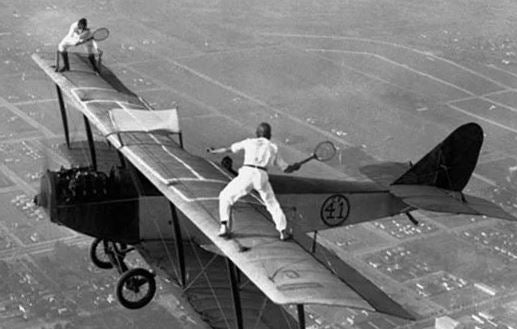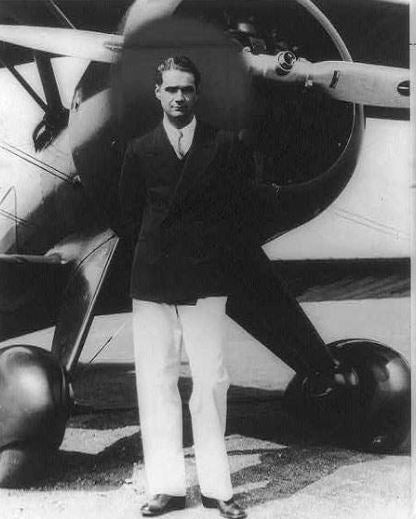A stunt is defined as an unusual or difficult feat requiring great skill or daring, especially one performed or undertaken chiefly to gain attention or publicity.
Recently, we’ve seen two “stunts” involving aviation—the YouTuber who intentionally crashed his airplane for video views and the Red Bull midair airplane swap. The FAA has taken a dim view of both events, and there have been discussions that the stunts were encouraged by social media. However, stunts involving aircraft go back to the early days of aviation, well before the invention of social media, the computer—and the FAA.
Barnstorming
In the 1920s, pilots flying surplus World War I aircraft toured the country as barnstormers. They would land in a farmer’s field and offer rides to the public or do aerial stunts for a price. Among the stunts often performed were the transfer from one aircraft to another by means of a rope ladder, or from an aircraft to a car, or vice versa. Another famous stunt was to have a performer hang from a rope ladder beneath the aircraft by their teeth.
Charles Lindbergh was one of these barnstorming pilots. According to Lindbergh, when he performed this stunt, in reality he had a cable wrapped around his body hidden by his jacket that kept him tethered to the aircraft and he just pretended to hang on by his teeth. He was also known for stunts involving parachutes.
In the 1920s, both parachutes and airplanes were relatively new technology and people paid to see both in action.
Wing Walking
Wing walking, the act of leaving the cockpit of an airplane and climbing onto the wing, was a popular stunt. This was often done using a biplane, and the person doing the wing walking held on to the struts and wires as they moved out on the wing.
This activity was often done by young women, which was demonstrated in the 1975 movie The Great Waldo Pepper, a aviation jaunt set in the 1920s featuring Robert Redford as a former World War I fighter pilot who exaggerates his experience and becomes a barnstormer. In order to create publicity for an upcoming performance in a small town, Pepper flies his biplane down main street with a young woman clad only in her underwear (because her clothes were blown off) clinging to the strut of the biplane.
Some airplanes had specially made footholds or harnesses for performers to hang on with. Sometimes, performers wore parachutes—but most often not, and they fell to their deaths if they lost their grip or made a misstep.
In 1938, the Civil Aeronautics Authority—the precursor of the FAA—citing the number of deaths, decreed that wing walkers had to wear parachutes.

Tennis, Anyone?
In 1925, tennis was gaining in popularity and two pilots turned stuntwomen, Gladys Roy and Ivan Unger, capitalized on this by playing a tennis match atop the wing of a biplane. The event was caught on film for both newsreels and newspapers.
Roy also set the record for the lowest parachute jump, deploying her parachute at 100 feet above ground. She was severely injured on impact, but lived to tell the story.
Accidentally on Purpose
Eleven years after Charles Lindbergh made his historic crossing of the Atlantic in the single-engine Spirit of St. Louis, Douglas Corrigan, a pilot/mechanic who had been part of Lindbergh’s team, bought a scrapped 1929 Curtiss Robin and rebuilt it, modifying it for long distance flight. In July of 1938.

Corrigan flew from California to New York. The transcontinental flight was not particularly newsworthy except for the fact the aircraft looked so fragile. The media of the day took note, and Corrigan gained a reputation as a daring aviator.
Upon arriving in New York, Corrigan filed a plan to fly from New York to Europe, but aviation authorities denied the request, calling it a suicide mission. Instead, Corrigan was granted permission to fly back to the West Coast.
A seemingly resigned Corrigan took off from Floyd Bennett Field on July 17 and headed west. A few minutes later, he turned to the east and disappeared into a cloud bank.
Approximately 28 hours later, Corrigan touched down in Dublin, Ireland, asking where he was. He claimed he got lost in the clouds and that his compass had failed, which was why he was so far off course. The authorities didn’t buy the story and suspended his license. Meanwhile, the press dubbed him “Wrong Way Corrigan” and he became an overnight celebrity.
Ask For Forgiveness, Not Permission
In 1947, Howard Hughes the pilot, inventor, and eccentric millionaire wanted to perform flight tests on the H-4, the so-called Hercules Flying Boat. The tests would take place in Long Beach Harbor in California.
The H-4 was the largest airplane ever built, sporting a wingspan of 320 feet and a height of 79 feet. The aircraft, designed during World War II, was made primarily of wood because wood was not a strategic material. The aircraft was designed to carry 750 troops aloft using eight Pratt & Whitney 3,000 hp radial engines.

The design and construction of the massive cargo ship was lengthy and expensive—the government eventually pulled the funding and Hughes paid out of pocket to finish the airplane. During the development, Sen. Ralph Owen Brewster from Maine was openly critical of both Hughes and the Hercules, referring to the wooden airplane as “The Spruce Goose,” although the aircraft was constructed primarily of laminated birch.
Hughes allegedly agreed to only perform taxi tests on the water on November 4, 1947. That morning, there were 16 mechanics, Hughes, two flight engineers and two crewmen, and several media and industry representatives on board as the tests began. Later in the afternoon, Hughes was ostensibly still only supposed to be taxing on the water; however, the aircraft lifted off and flew for approximately 26 seconds, covering one mile at an altitude of 70 feet above the water’s surface.
Hughes allegedly told the authorities that the liftoff was accidental, however, contemporaries of Hughes claim he did it on purpose to demonstrate that the aircraft could fly. When it was over, Hughes is said to have grinned and said, “I like surprises.”




